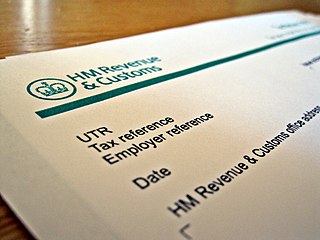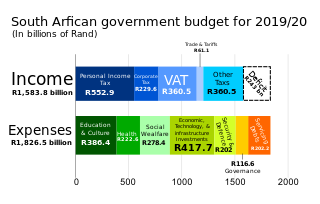Related Research Articles

National Insurance (NI) is a fundamental component of the welfare state in the United Kingdom. It acts as a form of social security, since payment of NI contributions establishes entitlement to certain state benefits for workers and their families.
A pay-as-you-earn tax (PAYE), or pay-as-you-go (PAYG) in Australia, is a withholding of taxes on income payments to employees. Amounts withheld are treated as advance payments of income tax due. They are refundable to the extent they exceed tax as determined on tax returns. PAYE may include withholding the employee portion of insurance contributions or similar social benefit taxes. In most countries, they are determined by employers but subject to government review. PAYE is deducted from each paycheck by the employer and must be remitted promptly to the government. Most countries refer to income tax withholding by other terms, including pay-as-you-go tax.
The Canada Revenue Agency is the revenue service of the Canadian federal government, and most provincial and territorial governments. The CRA collects taxes, administers tax law and policy, and delivers benefit programs and tax credits. Legislation administered by the CRA includes the Income Tax Act, parts of the Excise Tax Act, and parts of laws relating to the Canada Pension Plan, employment insurance (EI), tariffs and duties. The agency also oversees the registration of charities in Canada, and enforces much of the country's tax laws.

HM Revenue and Customs is a non-ministerial department of the UK Government responsible for the collection of taxes, the payment of some forms of state support, the administration of other regulatory regimes including the national minimum wage and the issuance of national insurance numbers. HMRC was formed by the merger of the Inland Revenue and HM Customs and Excise, which took effect on 18 April 2005. The department's logo is the St Edward's Crown enclosed within a circle.

In the United Kingdom, taxation may involve payments to at least three different levels of government: central government, devolved governments and local government. Central government revenues come primarily from income tax, National Insurance contributions, value added tax, corporation tax and fuel duty. Local government revenues come primarily from grants from central government funds, business rates in England, Council Tax and increasingly from fees and charges such as those for on-street parking. In the fiscal year 2014–15, total government revenue was forecast to be £648 billion, or 37.7 per cent of GDP, with net taxes and National Insurance contributions standing at £606 billion.

A retirement plan is a financial arrangement designed to replace employment income upon retirement. These plans may be set up by employers, insurance companies, trade unions, the government, or other institutions. Congress has expressed a desire to encourage responsible retirement planning by granting favorable tax treatment to a wide variety of plans. Federal tax aspects of retirement plans in the United States are based on provisions of the Internal Revenue Code and the plans are regulated by the Department of Labor under the provisions of the Employee Retirement Income Security Act (ERISA).
In the United Kingdom, a P60 is a statement issued to taxpayers at the end of a tax year. It is important a taxpayer does not destroy the P60 forms issued to them, as they form a vital part of the proof that tax has been paid. They were also issued in Ireland until the 2018 tax year.

In the United Kingdom, a tax return is a document that must be filed with HM Revenue & Customs declaring liability for taxation. Different bodies must file different returns with respect to various forms of taxation. The main returns currently in use are:

Taxation in Ireland in 2017 came from Personal Income taxes, and Consumption taxes, being VAT and Excise and Customs duties. Corporation taxes represents most of the balance, but Ireland's Corporate Tax System (CT) is a central part of Ireland's economic model. Ireland summarises its taxation policy using the OECD's Hierarchy of Taxes pyramid, which emphasises high corporate tax rates as the most harmful types of taxes where economic growth is the objective. The balance of Ireland's taxes are Property taxes and Capital taxes.
Tax withholding, also known as tax retention, pay-as-you-earn tax or tax deduction at source, is income tax paid to the government by the payer of the income rather than by the recipient of the income. The tax is thus withheld or deducted from the income due to the recipient. In most jurisdictions, tax withholding applies to employment income. Many jurisdictions also require withholding taxes on payments of interest or dividends. In most jurisdictions, there are additional tax withholding obligations if the recipient of the income is resident in a different jurisdiction, and in those circumstances withholding tax sometimes applies to royalties, rent or even the sale of real estate. Governments use tax withholding as a means to combat tax evasion, and sometimes impose additional tax withholding requirements if the recipient has been delinquent in filing tax returns, or in industries where tax evasion is perceived to be common.
The National Insurance number is a number used in the United Kingdom in the administration of the National Insurance or social security system. It is also used for some purposes in the UK tax system.
IR35 is the United Kingdom's anti-avoidance tax legislation, the intermediaries legislation contained in Chapter 8 of Income Tax Act 2003. The legislation is designed to tax 'disguised' employment at a rate similar to employment. In this context, "disguised employees" means workers who receive payments from a client via an intermediary, i.e. their own limited company, and whose relationship with their client is such that had they been paid directly they would be employees of the client.
Pensions in the United Kingdom, whereby United Kingdom tax payers have some of their wages deducted to save for retirement, can be categorised into three major divisions - state, occupational and personal pensions.
A stakeholder pension scheme is a type of personal pension in the United Kingdom.
In the UK, every person paid under the PAYE scheme is allocated a tax code by HM Revenue and Customs. This is usually in the form of a number followed by a letter suffix, though other 'non-standard' codes are also used. This code describes to employers how much tax to deduct from an employee. The code is normally based provided to HMRC by the taxpayer or their employer.
The Tax Law Rewrite Project of HM Revenue and Customs was a major effort to re-write the entire tax legislation of the United Kingdom in a format which is both more consistent and more understandable. It aimed to remove archaic language and impenetrable terminology from tax law and to replace it with modern language and terminology.
An honorarium is an ex gratia payment, i.e., a payment made, without the giver recognizing themselves as having any liability or legal obligation, to a person for his or her services in a volunteer capacity or for services for which fees are not traditionally required. It is a common remuneration practice in schools or sports clubs, for teachers and coaches. Another example includes the payment to guest speakers at a conference meeting to cover their travel, accommodation, or preparation time. Services for Christian Church funerals and/or memorial services are often paid by honorarium, as the minister, musicians, organist, soloist and others, out of care, do not have a set fee for services to grieving families. Likewise, wedding officiants are sometimes paid through honorarium. When required, honorariums may be termed altarages, although an altarage may be paid to a church or parish rather than a person.

Defined benefit (DB) pension plan is a type of pension plan in which an employer/sponsor promises a specified pension payment, lump-sum, or combination thereof on retirement that depends on an employee's earnings history, tenure of service and age, rather than depending directly on individual investment returns. Traditionally, many governmental and public entities, as well as a large number of corporations, provide defined benefit plans, sometimes as a means of compensating workers in lieu of increased pay.

Taxation may involve payments to a minimum of two different levels of government: central government through SARS or to local government. Prior to 2001 the South African tax system was "source-based", where in income is taxed in the country where it originates. Since January 2001, the tax system was changed to "residence-based" wherein taxpayers residing in South Africa are taxed on their income irrespective of its source. Non residents are only subject to domestic taxes.
An Employer Reference Number Number or Employer PAYE Reference is a unique reference number issued in the United Kingdom by HMRC to an employer. Every organisation operating a Pay As You Earn (PAYE) scheme is allocated an ERN, a unique set of letters and numbers used by HMRC to identify each employer, consisting of a three-digit HMRC office number and a reference number unique to each business.
References
- ↑ "PAYE forms - P45, Starter Checklist, P60 and P11D". HM Revenue & Customs. Retrieved 18 May 2013.
- ↑ "When an employee leaves or retires". HM Revenue & Customs. Retrieved 18 May 2013.
- ↑ "Help guide on P45's". Smart Pension. Retrieved 28 April 2023.
- ↑ "PAYE93080 - Reconcile individual: end of year reconciliation: small pension taken as a lump sum payment (formerly known as trivial commutation payments)". HM Revenue & Customs. Retrieved 24 April 2023.
- ↑ "P45 Form: United Kingdom Tax Form, What it is, How it Works". Investopedia. Retrieved 23 January 2024.
- ↑ Reddan, Fiona. "Bye bye P45: Revenue moves to modernise PAYE". The Irish Times. Retrieved 5 July 2020.
- ↑ "Tony Blair's last Prime Minister's Questions: 27 June 2007". YouTube (Video). 27 June 2007. 21 minutes, 17 seconds. Archived from the original on 21 December 2021. Retrieved 18 September 2020.
- ↑ "Hansard: The Prime Minister". 27 June 2007.
- ↑ Elgot, Jessica Elgot; Grierson, Jamie (4 October 2017). "Security inquiry after prankster Simon Brodkin disrupts May speech". The Guardian.
- ↑ "Conservative conference: May handed P45". BBC News. 8 October 2017.